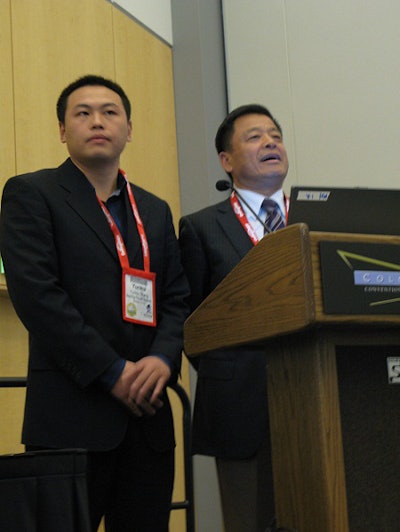 Guangfa Wang (right), principal of Beijing Royal School, touts his students’ work ethic.
Guangfa Wang (right), principal of Beijing Royal School, touts his students’ work ethic.DENVER — As a hunting ground for recruiting students, China may seem daunting. It’s vast and far away, with a difficult official language and unfamiliar culture.
But there are ways of tapping into this huge market, especially with the Internet, speakers said last week at a conference of the National Association for College Admission Counseling.
China’s sheer numbers make it enticing to recruiters. It’s the most populous nation in the world, with 1.3 billion people, a fifth of all human beings. The fastest growth is among the second and third tier cities, experts say. Even third-tier cities — there are about 160 — have populations of more than a million.
China, South Korea and India are the top generators of students to the U.S., but China is seen as the only source of growth at this point, according to Dr. Rahul Choudaha, director of research at World Education Services. A total of 56,976 Chinese students enrolled in the U.S. as undergraduates in 2010-11, compared with 9,988 in 2006-07, data show.
Entrance to the top Chinese universities is very tough, so many parents send their children to schools in the U.S. for their high quality and the chance to become proficient in English, a valuable skill, admissions officers say.
Universities in the U.S. are eager to recruit Chinese to help achieve global diversity on their campuses and benefit from the full tuition that the students and their parents are willing to pay. In fact, critics have accused financially-strapped flagship universities of giving foreign students spots that should be allocated to state residents.
Choudaha said the challenge for admissions officers is to bring in qualified applicants and build their schools’ brand despite shrinking recruitment budgets.
Since travel to and within China can take so long, it’s best for admissions officers to devise a plan that fits their school’s resources, according to Juana Alcala, director of admissions marketing and recruitment at the University of Montana.
High schools in Shanghai and Beijing are very brand conscious when it comes to universities, “so we retooled and went to secondary markets, and now tertiary,” Alcala said. “We focus on very specific cities.”
Schools should get on Renren, Sina Weibo and Youku, China’s social networking websites, and may want to create their own Chinese sites, she said. Although many Chinese parents use Sina Weibo, fewer than 50 schools had accounts with it, so that’s one opportunity, she said.
She said schools should explain terms that might not be understood, such as “faith-based,” and talk about the safety of students, which admissions advisers say is a source of worry for many Chinese parents.
Representatives from Alcala’s school travel three times a year — in the fall, in March for “relationship-building” and in June to meet students who are late in the applications game.
Chinese students already on campus can be a powerful recruitment tool. Their online photos and postings about campus life can hold strong appeal for friends back at home, according to speakers at the conference.
Recruitment videos can incorporate videos made by students, said Sid Krommenhoek, a founder of Zinch, a college admissions portal for students that has an office in China.
“These videos are very simple to create, very authentic,” he said. “Let their personality come out — ‘Here’s my dorm room, here’s my roommate, cafeteria,’” he said. “Make a lot of videos.” Students can be given opportunities to be ambassadors for their schools. Use your Chinese alumni and alumni groups, he said.
Become familiar with the Chinese high schools and their testing, holidays, and customs, said David McCauley, Jr., deputy director of college counseling at Beijing National Day School.
Competition to recruit students is fierce, he said. “Get someone who knows the language.”
Aimee Thostenson, associate director of international admission for St. Catherine University in St. Paul, Minn., which enrolls students from 31 countries, said her “armchair strategies” including outreach to sponsoring organizations and to foreign high school counselors and university staff members, word of mouth, and advertising.
School representatives can’t travel, so they try to meet those in the field at conferences and other events. The school began using the Common Application, which, though costly, led to more foreign applicants, she said.
Challenges include the lack of a Minnesota consortium that would help schools pool their efforts and limited financial aid, she said. Sometimes the school can’t help a high academic achiever with poor finances.
St. Catherine hasn’t hired outside agencies, a controversial issue among admissions officers. A survey of admissions directors conducted this year by Inside Higher Ed found 68 percent of respondents at four-year public universities and 46 percent at four-year private institutions thought agents help applicants fabricate information on their applications.
About 20 percent of directors at four-year colleges say they use commission-based agents to recruit foreign students. Most support a proposal to bar that type of compensation.
Choudaha said schools can use help, not necessarily from agents, but from third parties who know the students and the market dynamics.
Representatives of two elite high schools in China told the conference that their programs stressed proficiency in English, which some say is lacking in too many foreign students.
Jiangsu Tianyi High School in Wuxi began offering students Advanced Placement courses in English in 2009. At Beijing Royal School, students learn in both Mandarin and English and use bilingual AP textbooks, officials say.















